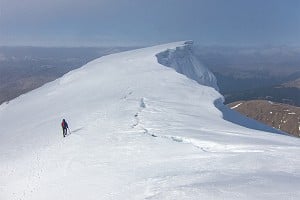
For many British alpinists the winter season can be hard work. Low temperatures and short days mean speed is of the essence. But winter brings one thing that can make moving through the mountains either a slow slog or a speedy slide - snow.
Snow is fast to ski on, but can be very slow to walk through if it is deep, as you sink in with each step. Gaining ground through snow like this is called 'breaking trail' and is slow, hard work best left to your climbing partner...
You can avoid sinking in to the snow by increasing the surface area of the bottom of your feet, either with skis or with snow shoes - spreading your load over more snow. The advantage of skis is that they let you slide downhill. The disadvantage is that you can crash if you can't ski!
In this article we look at different techniques and different equipment for moving through the mountains in winter.
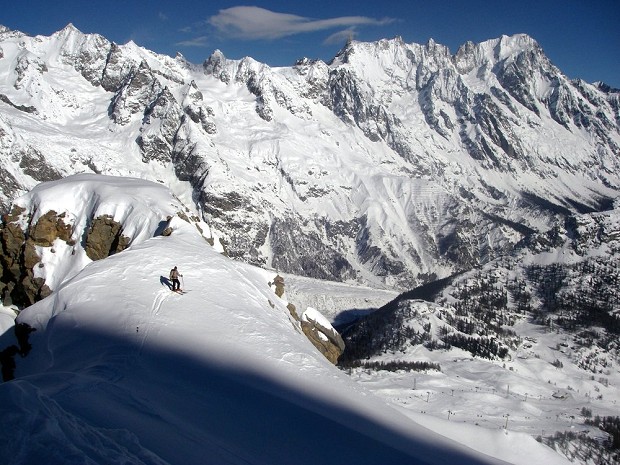
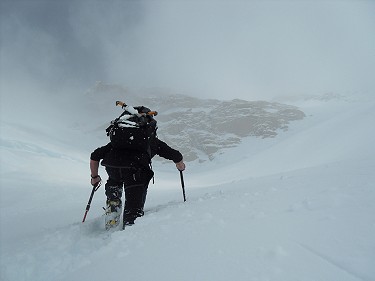
1. Walking
Pros:
- Cheap
- No specialist skill required
- No extra gear to be carried
Cons:
- Slow
- Hard Work
- Did I mention slow?
When is walking appropriate?
Walking is a common form of mountain travel, especially in the summer, but when the snow is deep it can be a trail-breaking nightmare. However for those climbers who are unable to ski, and don't have the time or money to learn, it is a safe, cheap option (attempting to ski when you don't have the skill set can be very dangerous).
If you are committed to walking (and on many occasions I can't recommend it!) then choose routes that have very short approaches and descents. Long descents down glaciated terrain (such as the Valley Blanche, Mont Blanc Range) are a walker's nightmare, and what would take thirty minutes on skis may take you eight hours in bad snow.
Check current snow conditions before you make any plans. If it has just dumped with powder snow close to your objective, walking several km is not going to be easy. However if the snow is hard and well consolidated, it may be a simple romp with boots and crampons.
Capitalise on your walking prowess by choosing routes that don't descend the same way as they went up, meaning that the fact you are not carrying skis on your back whilst climbing works in your favour.
For walking in the mountains in winter you don't need any extra gear that isn't listed in the 'general gear list' at the base of this article, however you might not save any money in the long run as you will need to refuel your body with pizzas and beer after the epic slogs you have endured before and after your routes!
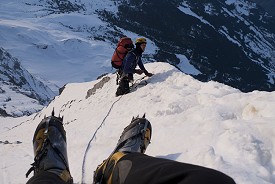
The Spantiks are exceptionally warm, the double boots perform really well on cold climbs, and are ideal for multiday or very cold north face routes.
With a bit of practice it is also possible to ski in these beauties. See later in the article!
Jon Griffith reviewed the Spantiks in full detail here: UKC Gear Review
He said: "Overall verdict? Brilliant."
Double boots like the Spantiks are extremely warm and can give peace of mind when the conditions are cold - these remain a firm favourite for many alpinists who have previously suffered frostbite (in less warm boots) and need to really look after their feet.
Similar boots worth a mention are the Phantom Guide 6000 from Scarpa.
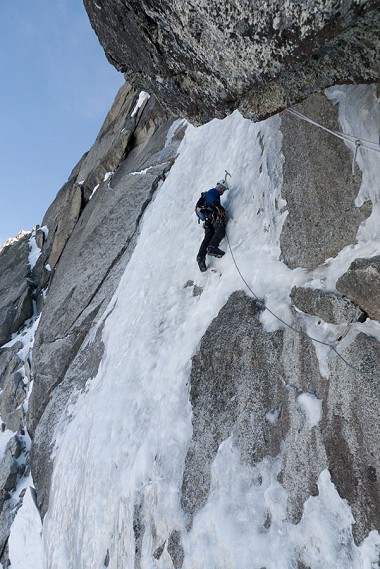
Example Walker's Route: Fil a Plomb, Col du Plan, Chamonix.
Fil a Plomb can be a perfect "walker's route" because it has a relatively short uphill approach and you can ride the cable car back down! The short uphill approach means that under firm snow conditions you won't save much time by skiing (with touring skis) to the route, however you would save some time in very deep snow conditions.
The fact that you can descend via the cable car means that skis would be of absolutely no use in the descent, and would be an inconvenience on the route itself, possibly negating much of the time they saved on the approach.
- For more info on Fil a Plomb, a classic ice route close to Chamonix, check the UKC Logbooks.
Equipment Recommended For Walking: No extra gear needed, but many people opt for trekking poles.
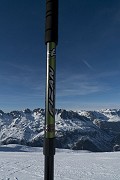
The 'Everest' is top pole maker Fizan's lightest 'mountaineering' pole. It weighs in at just 220gm and has three sections ranging from 64-140cm.
It comes with three different snow baskets for a range of conditions and has a foam grip at the top of the pole as well as the handle for use traversing slopes.
More info: Fizan Website
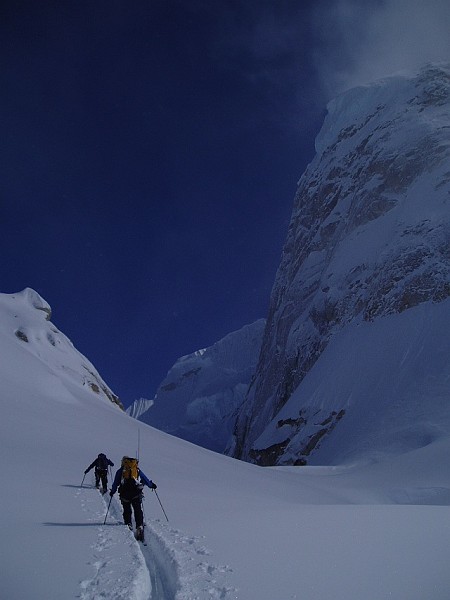
2. Skiing
Pros:
- Really Fast
- Much more energy efficient than walking
- Good fun!
Cons:
- Needs skill
- Equipment costs a lot of money
- Skis and associated gear is heavy to carry on route
When is skiing appropriate?
Skiing is an appropriate method of mountain travel for much of the winter season and often in autumn and spring too. In fact for much of the year many alpine routes can be approached faster, and with less energy on skis.
I can't recommend strongly enough to any aspiring alpinist that they should learn to ski to a reasonable standard.
So I've got to the route - but what do I do with my skis?!
You either carry them up the route or you leave them at the bottom. Routes that can be abseiled back down (many ice couloirs) are perfect objectives to ski in and out from. You can leave your skis at the base of the route, climb until you either reach the top or get to a time where it is a good idea to start going down, and abseil back to your skis.
If the route is not appropriate to abseil, then you can leave you skis at the bottom and collect them later - either a day or two after you have walked off the back of the mountain or later the same day if it is possible to get back to the base of the route quickly. It is quite normal for climbers to use the speed of skis to approach a route quickly, but then to leave the skis stashed at the base for a couple of days until they manage to get back up on a spare day to collect them.
Carrying your skis can be hard work on technical ground, but on open couloirs and snow slopes it isn't too difficult. Having lightweight skis means that they are much easier to carry and the difference in weight between a lightweight touring ski and a heavyweight alpine ski is very large.
Small specialist skis are great to carry but not so great to ski on - it depends where your priorities (and finances) lie.
Black Diamond , the well known climbing gear manufacturer are also heavily in to their ski gear. I got in touch with them and asked a few basic questions about what ski set up they would recommend for a climber. I also asked them to recommend specific models of their own skis and boots for different terrain.
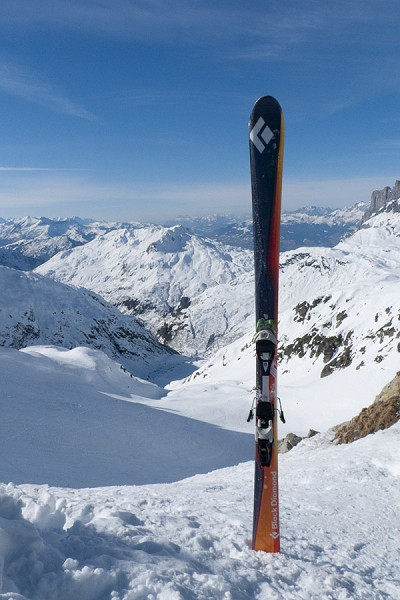
Jack: There are lots of different categories of ski out there: Alpine, Touring, Cross Country etc. Which category of ski should we look at for approaching climbs and why? What's the difference?
BD: You should look for the Alpine Touring (AT) / Ski Touring ski category. These skis are made for offpiste skiing but are lightweight enough for a longer approach to your climb. They work in all conditions – fresh snow, hardpack, crust etc. The difference between these and Alpine Skis is that Alpine skis are heavier and are made for skiing on pistes only. Freeride Skis are longer and wider for fast, long turns in powder and are made for off piste skiing, but although you get tons of fun on the 'down', you'll get less fun climbing up, because they are much heavier than touring skis.
Jack: I have climbed several winter routes wearing my ski touring boots. This has meant that I haven't needed to carry additional boots up in to the mountains. Do you have a certain model of ski boot that is better suited to this? What are the characteristics we should be looking for if we think we might end up climbing in our touring boots?
BD: The common touring boots are a good choice for such trips. They are lightweight, are easy to walk in and have a good rubber sole. You should choose a boot which is stiff enough to make sure that you are able to ski with a heavy pack on your back. Weight is another important criteria – it also depends on your leg size ;) and this is mostly not too big when you're a climber. The BD Prime or Swift is the perfect boot for this.
Jack: If you had to design the ideal skiing set up for a climber who wanted to be able to occasionally ski pistes with his friends, do some ski touring, but mainly ski to routes, through all sorts of terrain, and occasionally carry his skis with him up the route, what would you recommend? Skis, boots, bindings, the whole package. And why?
BD: Alpine Touring skis (BD Stigma) and Ski Touring boots (BD Prime). There are various binding options available – Dynafit bindings for weight oriented users, Fritschi, Silvretta or other bindings for more comfort oriented skiers. At the end you find your system with a good weight to performance ratio.
Jack: Around 10 years ago I experimented with some very short 'approach skis'. There were basically a snow shoe replacement, and easy to carry up routes, but terrible to ski on! I haven't seen many of these short skis in use in the mountains. Are they a viable option for climbers?
BD: Not really. You would be better using a shorter touring ski. The performance of those approach skis is very limited – the edgehold is not good enough in case you have to traverse a steeper face and they don't have enough surface for fresh snow...
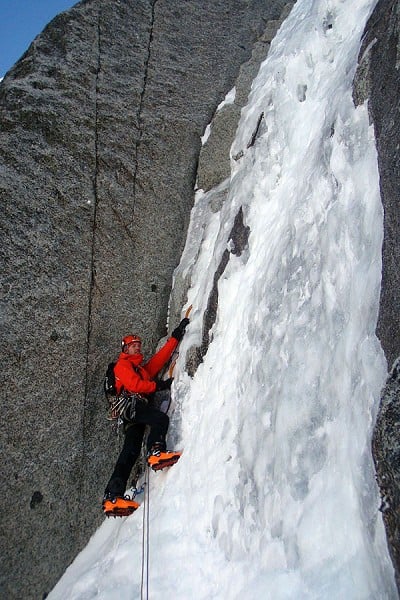
You either carry your climbing boots in your rucksack and switch out of your ski touring boots at the base of the climb, or to save weight you can climb in your ski boots or even ski in your climbing boots. The downside to carrying your boots in your rucksack and putting them on at the base of the route (aside from the fact that you have to carry them!) is that you will end up leaving your ski boots in cold temperatures all day whilst you are climbing and they can freeze up, making putting them back on your feet after your climb a very cold and unpleasant experience.
So - what about climbing in my ski touring boots? Many climbers opt for this approach and on most terrain it works quite well. Ski touring boots readily accept a crampon (my Scarpa Maestrale ski boots are actually smaller than my La Sportiva Spantik climbing boots!) and are very supportive to climb in.
They are ideal for long snow and neve slopes, giving a huge amount of calf support, helping to reduce that killer leg burn. They are not as comfortable or as dexterous as climbing boots. They are also not a warm as proper winter mountain boots such as Spantiks or Scarpa Phantom 6000's. They are much warmer than most single layer summer alpine boots though (just don't fasten them up too tight) and I have climbed several winter alpine routes in mine.

The striking orange and black Scarpa Maestrale touring boots weigh in at a mere 1530gm. They are a four buckle boot, giving really good support whilst skiing, but using a newly designed super thin shell, Scarpa have been able to keep this boot as the lightest in their touring range.
I have comfortably used these boots for trad mixed climbing up to around M6 and I am sure a more talented climber could go much harder. Nick Bullock for instance is well known for climbing really hard mixed routes in his ski touring boots (but he is mad!).
- Full info: Scarpa Website
The dark art of skiing in climbing boots!
UKC Alpine Correspondent Jon Griffith skis mainly in his La Sportiva Spantik climbing boots, even when he is on the piste. And let me tell you - he can carve the slopes in those yellow and silver booties. Why and how does he do that?
"I have put in a couple of years of effort learning to ski in my Spantiks." explained Jon. "It helps to be a good skier in the first place, and it is hard work to learn, but it has huge benefits. Climbing boots are much better for climbing in, are warmer and you look cool skiing in Spantiks!"
"Many people say that skiing in climbing boots is impossible, but it's not. Think about your first day on skis - it felt pretty impossible even in ski boots! You just need to re-learn how to ski. If you look at the old leather boots people used to ski in many years ago, and the wooden skis they used, it quickly becomes apparent that skiing in supportive mountain boots like Spantiks is certainly not impossible. Skiing in my Spantiks means I don't have to carry my climbing boots in my rucksack and also means I don't have to leave my ski boots out on the glacier all day to freeze solid."
"As for bindings, you want the Silvretta Pure Performance Carbon fibre touring set up, but you'll have to pad out the front toe bail with a bit of foam mat (very easy). Petzl are in the design process of a lightweight binding for mountain boot use but that's still a couple of years away yet."
- Jon talks a little more about skiing in his climbing boots and also about weights and lengths of skis in this UKC Ski Review.
It is worth noting that this is actually pretty difficult to do safely and well, but once you have mastered this technique it is certainly a large tool in your alpine toolbox.
"Climbing boots are much better for climbing in, are warmer and you look cool skiing in Spantiks!"
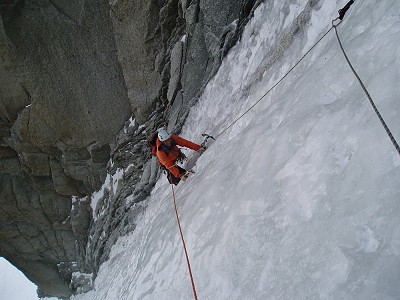
As recommended by the British Mountain Guides , the Super Couloir is an ideal route to approach on skis. A mainly downhill ski approach from the Aiguille du Midi cable car leads to the route (20 mins on skis. 2 hours walking or snow shoeing). After abseiling down the route to collect your skis it is a 1.5 hour ski out down the Valley Blanche (or a 4+ hour walk depending on snow conditions!).
Most parties abseil this route, meaning ski retrieval is easy, however even if you top out the route, the descent from Mont Blanc du Tacul can still land you back at your skis and ready to ski out. Ideal.
- See this UKC article for full details on the Super Couloir: BMG Route Card
Equipment Recommended for Skiing: Touring skis, touring boots, poles, skins.
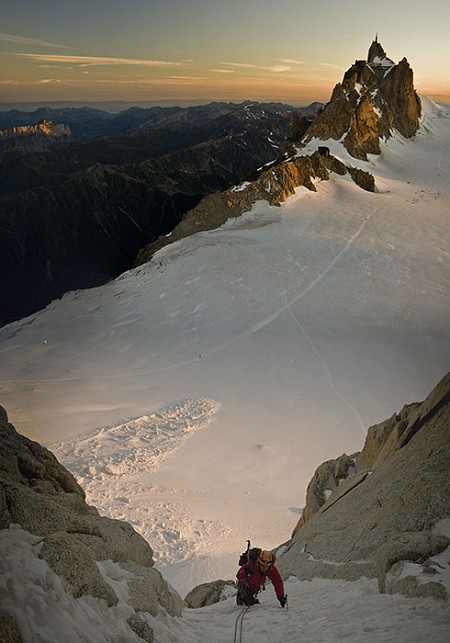
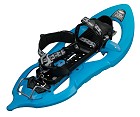
3. Snow Shoeing
Pros:
- Cheaper than skis
- Minimal specialist skill required
- Shorter, therefore easier to carry on route than skis
Cons:
- Slower than skiing
- Hard work, even on the down-hills.
- Not cool!
I have to say it straight away... Amongst most Alpinists snow-shoeing is considered to be a bit 'naff' and snow-shoers can expect a bit of piss-taking in the pub. And why not - we all know climbing is about a good bit of banter!
BUT: They do have their place and they can be a useful bit of mountain kit.
When is snow-shoeing appropriate?
If there is a lot of snow on the ground, making walking a very difficult task, then it might be time to think about a pair of snow shoes. Routes with generally short and flat approaches and descents that do not involve long downhill sections (that could be shredded fast on skis) can be considered good options for snow-shoeing.
Example Snow-Shoe Route: Chere Couloir, Mont Blanc du Tacul, Chamonix.
The Chere Couloir is approached relatively quickly from the Aiguille du Midi cable car station via a fairly flat walk across the upper Valley Blanche. It can be climbed in half a day and then the cable car station can be accessed by reversing the approach walk. A shortish flat approach like this can be done on snow shoes. In deep snow walking this approach could be extremely tiring and slow-going - meaning snow shoes could save you several hours of trail breaking.
- For more info on the Chere Couloir - see the UKC Logbooks.
I can't claim to be an expert on snow shoes, but I do know that the snow shoe manufacturer TSL are well regarded and their snowshoes are imported in to the UK by Allcord . If you do know a lot about snow shoes - please feel free to post on the forums.
Equipment Recommended for Snow Shoeing: Snow Shoes, Poles.
General gear for winter mountain travel
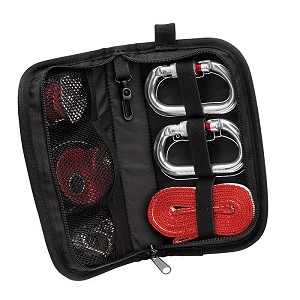
Crevasse Rescue:
You are going to be spending a lot of time crossing glaciated terrain - which means exposure to crevasses. You will need to know how to haul yourself out of one, and it is not easy.
Hauling a heavy climber out of a crevasse is hard work, and thinking you can do it with a couple of krabs and an old prusik cord will mean you are going to have your work cut out! Having been a climbing instructor for quite some years, and having had to haul a few people on various climbing assessments (and in one real life situation in Pembroke!) I can confirm it is desperately hard.
Having a pulley and a proper device to grab the rope makes your life so much easier (have you ever tried prusiking up a rope with actual prusik knots, compared to ascenders...) and Petzl have come up with a complete crevasse rescue kit that has everything you need in it, and a quick reference card showing how to rig a pulley system.
If I have been out ski touring, I have actually taken the kit in its bag, and when out climbing, I have stripped the essential bits out and slung them on my rack.
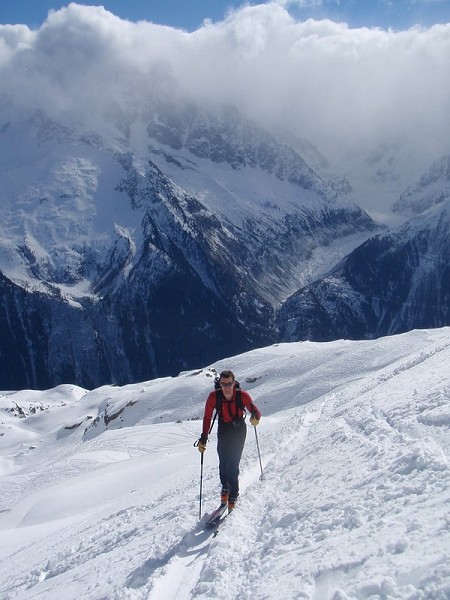
Whether you are skiing, snow-shoeing or even walking, getting through the snow is going to mean you are going to need trekking poles of some description. They will need to be telescopic, so you can put them in or on your rucksack, they will need to be strong too - off piste skiing with a heavy bag through bad snow means you will be doing some hefty 'poling'. There are quite a few different brands on the market - you could try Fizan or Black Diamond for a start.
Shovel, Probe and Transceiver:
For virtually all off piste skiers these days a shovel, probe and transceiver has become standard issue equipment. You just won't get asked out for a ski if you don't have this gear.
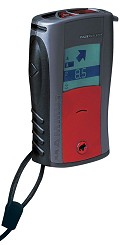
The Pulse is Mammut's super high-tech transceiver and, whilst being reasonably simple to use and very effective at finding casualties, offers a range of features that no other transceiver has.
"Vital data is detected by motion sensors that improve chances in multiple-burial situations; heart pulse detection, heart pulse trend and automatic burial detection."
Many serious off-pisters have a pulse, and they are considered to be one of the best transceivers, but they do take a bit of practice to use to their full potential.
More details: UKC Product News
And skiing in and out from routes is potentially some of the toughest and most dangerous off piste skiing you can do, so carrying this gear may well save your life. If you know how to use it.
A metal shovel is the way to go (plastic ones just aren't as good) and a longish probe is handy too. And your transceiver is important.
I currently have a Mammut Alugator super light shovel and a Mammut super light probe and luckily I haven't had to use either in anger.
THE transceiver to have at the moment seems to be the Mammut Pulse, although there are plenty of others on the market. Whichever you buy, make sure you know how to use it, and also make sure the batteries are fully charged.
If you are hiring a transceiver - please note - the hire shop won't provide batteries - you'll need to buy your own.

About the author:
Jack Geldard is UKC's Chief Editor. He has been climbing for 18 years and his experience ranges from the gritstone edges of Yorkshire, to big wall rock climbing in several continents all the way through to multiday winter alpine routes in various parts of Europe.
He recommends skiing as the way to travel in the mountains in winter - although he maintains a firm 'do what I say, not what I do' stance after recently being called "Beast on rock, giraffe on skis" by UKC Alpine correspondent Jon Griffith, when they were climbing in the Mont Blanc range this January.
He has recently been skiing on Black Diamond Stigma skis, with Scarpa Maestrale boots. He can't ski in his climbing boots, but he thinks he can out climb Jon Griffith wearing roller skates...
- SKILLS: Acclimatising for the European Alps 5 Jun, 2016
- REVIEW: Doug Scott - Up and About 2 Feb, 2016
- REVIEW: Primus Lite+ 8 Oct, 2015
- REVIEW: Ski Touring by Bruce Goodlad 4 Jun, 2015
- REVIEW: MSR WindBoiler Stove 13 Apr, 2015
- DIGITAL FEATURE: Starlight and Storm: Alison Hargreaves and Tom Ballard 30 Mar, 2015
- INTERVIEW: Ben Tibbetts - The Man Behind The Lens 3 Dec, 2014
- REVIEW: La Sportiva Nepal Cube GTX Boots 26 Jun, 2014
- Arc'teryx Launch Footwear Line 23 Jun, 2014
- Skiing for Mountaineers - Skiing Explained 16 Feb, 2014



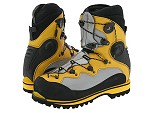
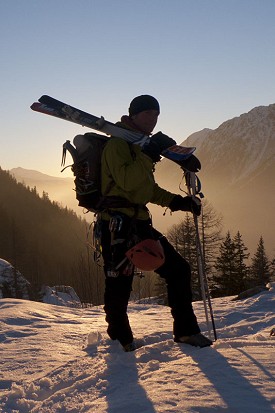
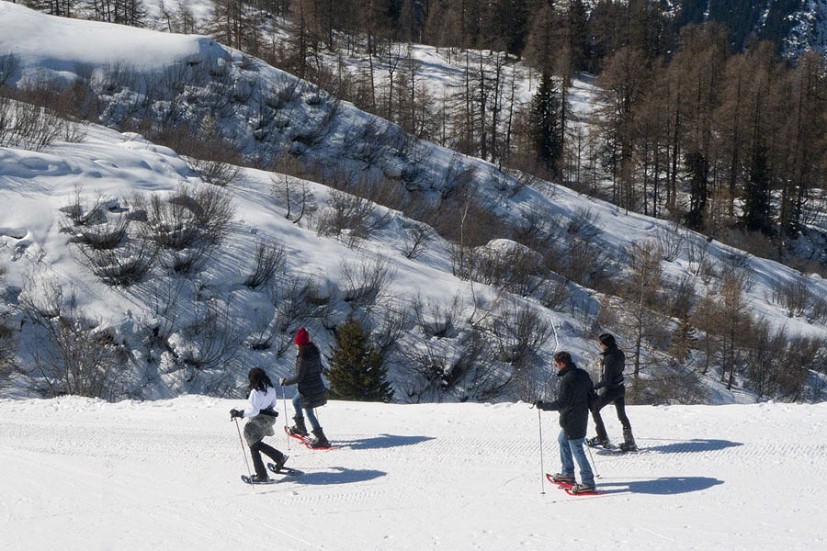
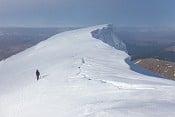
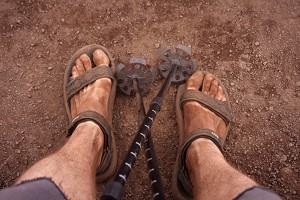
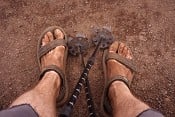
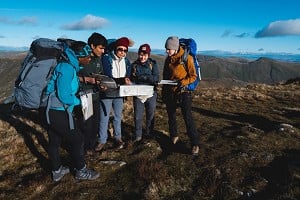
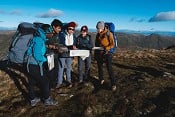




Comments